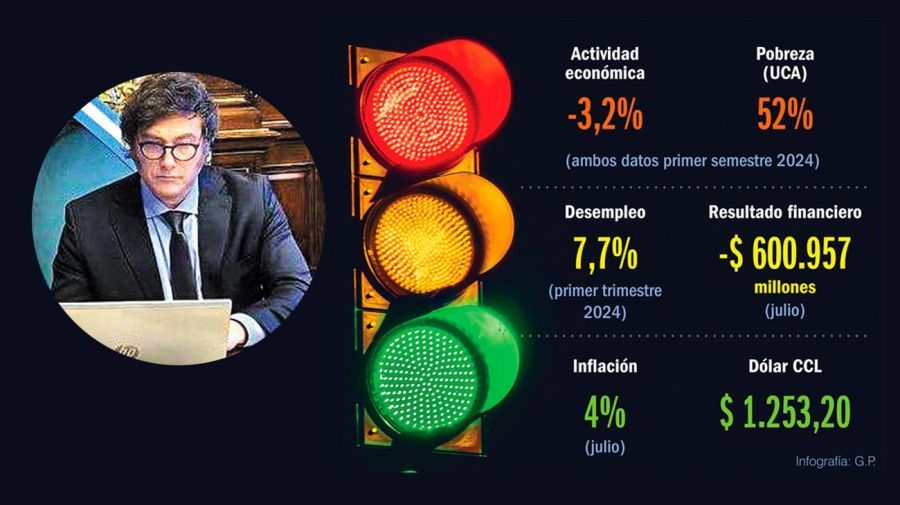The start of the week saw President Javier Milei closing out the first nine months of his administration. Argentina’s head of state has some positive results to show on the economic front, but he has not only failed to improve most indicators, many have actually worsened.
The economy is not taking off. Data from the INDEC national statistics bureau’s EMAE (Estimador Mensual de Activitidad Económica) measurement shows a fall of 3.2 percent in activity in the first half of the year.
Most alarming, however, is the increased poverty and destitution. INDEC’s official measurement will not be published until the end of the month, but according to a top body at the UCA Catholic University, 52 percent of the population today live with their basic needs unsatisfied, while 17.9 percent are destitute.
“I’d say all the indicators of the real economy are in the red with 10,000 less PyMES [small and medium-sized companies] and the Central Bank’s REM [monthly expectations] survey estimating this year’s slump at 3.8 percent or approximately eight percent without the farm sector,” said Hernán Letcher, the director of CEPA economic think tank.
“Poverty and destitution are also up with real wages losing 13 points on average between registered, informal and public employees,” he told Perfil.
Economist Francisco Ritorto, from the ACM consultancy firm, stated: “While we are seeing some recovery, it’s slow and taking its time being any complete recuperation, falling short of economic growth, I believe.”
Ritorto told Perfil that “an adjustment of activity on this scale is only comparable with [the] 2002 [economic crisis], I’d say.”
The numbers of some sectors frequently show monthly rises, while maintaining year-on-year falls. The metals sector grew 1.3 percent in July as against June but slumped 11.7 percent in inter-annual terms.
Elio Del Re, the head of the Adimra association of metal manufacturers, analysed: “Production continues falling in most sectors making up the metal industry although it seems to have bottomed out.”
The construction index dipped 4.3 percent for a cumulative slump of 29.3 percent so far this year. Total installed capacity was 54.5 percent in June when it was 68.6 percent in the same month last year.
As measured by Scentia consultants, consumption fell 16.1 percent in July as against the same month last year with a cumulative regression of -9,6 percent. The fall in retail sales, according to CAME mid-sized retailers’ association, reached 17.2 percent in the first half of the year.

Amber lights
Milei’s government has maintained fiscal balance since its first month in office. The La Libertad Avanza leader flaunts this as one of the great achievements of his administration, although, as Letcher observed, “the fiscal improvement has been mostly at the expense of pensions with a strong negative impact on [economic] activity.”
Despite this, the public sector registered a financial deficit of almost 601 billion pesos in July. In that sense another figure to mark out is that revenue is not recovering – in real terms it stays negative in two-digit levels.
Another figure which has worsened is unemployment although it remains single-digit. Due to the recession and the closure of companies, it increased two percentage points in the first half of the year to 7.7 percent.
The accumulation of reserves in Central Bank coffers started off with a green light but found its limits within the government programme. Milei received gross reserves to the tune of US$21.209 billion and closed out his third quarter with US$27.463 billion.
“Some US$17 billion were purchased but the impact for reserves was only US$8 billion due to factors pressuring accumulation,” pointed out Ritorto.
When considering BOPREALs, net international reserves are currently negative to the tune of US$5.041 billion, according to the calculations of CEPA.
PPI (Portfolio Personal de Inversiones) estimates project that if the government maintains its current course, the negative terrain would be US$10.919 billion by the end of the year – i.e. in the same order as prior to Milei’s inauguration when they were US$10.545 billion in the red.
Another indicator remaining in a grey area is its country risk rating. The index, elaborated by JP Morgan, posted a considerable drop from 1,920 base points before Milei took office to this year’s April 23 floor of 1,174 points. From there it has risen again to close Milei’s third quarter at 1,489 units.
Even if still over 400 points below December 8, 2023, it remains far removed from the levels necessary for the country to be financed on the international market, for which a range of 800-1,000 base points would be needed.
Green lights
One of the positives and the axis of the Milei’s government’s narrative is inflation. After the December devaluation sent it soaring 25.5 percent, inflation marked a downward path until reaching four percent in July.
“This year inflation will be lower than last year, thus keeping a campaign promise and responding somewhat to what was the main social demand,” forecast Ritorto.
Finally, the exchange rate stability on both the official and parallel markets is another positive which the current government can display. Milei received the CCL (contado con liquidación) exchange rate at 991.60 pesos and it closed his third quarter at 1,253.20 pesos, implying a rise of barely 26 percent during his government.
While the economic team has kept the gap between official and parallel exchange rates down, it has done so at a cost of dollars which the Central Bank could not accumulate and with a constant intervention at odds with the freedom of supply and demand.


























Comments